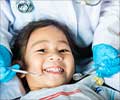Bacteria lurking in the water lines at the dentist's office are tougher than we thought, suggested a new paper.

‘During dental procedures, patients and dentists can be exposed to microorganisms present in the water circulating inside dental units.’





In the new study, researchers analyzed three disinfectants used by some European dentists to control biofilms in dental water lines: Calbenium®, Oxygenal 6® and Sterispray®. The team tested how well the disinfectants removed biofilms from dental water lines and found that none of them were completely effective on a polymicrobial biofilm. Dr. Damien Costa, lead author of the study, said, "During dental procedures, patients and dentists can be exposed to microorganisms present in the water circulating inside dental units. Infections may occur if this potentially microbiologically contaminated water is inhaled or splashed. We wanted to determine the best way to keep dental lines clean and avoid infection."
There has long been concern about how clean dental lines are, and there have been some - albeit rare - documented cases of them causing infections in people. In 2011, an 82-year-old woman was admitted to hospital with trouble breathing and was diagnosed with Legionnaire's disease, which she had contracted via a contaminated dental water line. She died two days later.
One challenge associated with keeping dental water lines clean is that bacteria can grow in communities with protective layers over themselves, called biofilms. Biofilms can be particularly difficult to prevent and remove even using disinfectants.
Dr. Costa and his colleagues grew biofilms in the laboratory in conditions similar to dental water lines. The biofilms contained several different microbes, to mimic the complex biofilms that form in real lines: the bacterium Pseudomonas aeruginosa, which can cause pneumonia and septic shock, the fungus Candida albicans, which can also cause superficial and severe infections, and free living amoebae Vermamoeba vermiformis. These amoebae can be dangerous - they're known as 'Trojan horses' because they carry some bacteria that can infect humans, like Legionella pneumophila, which causes Legionnaire's disease.
Advertisement
Dr. Costa said, "Unfortunately, our results showed that none of the three disinfectants commonly used are completely effective. What is most worrying is that none of the disinfectants could kill the amoebae, which means they are still dangerous to patients and dentists even after water lines have been sterilized."
Advertisement
Source-Eurekalert













